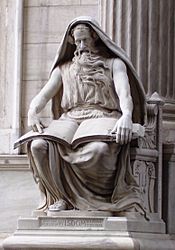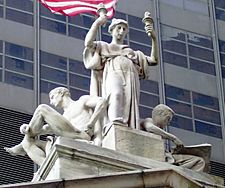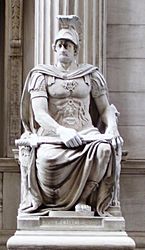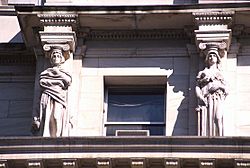Appellate Division Courthouse of New York State facts for kids
|
Appellate Division Courthouse
of New York State, First Department |
|

(2010)
|
|
| Location | 35 East 25th Street Manhattan, New York City |
|---|---|
| Built | 1896–1899 |
| Architect | James Brown Lord Rogers & Butler (1925 annex) |
| Architectural style | Late 19th and 20th century revivals, Renaissance Revival |
| NRHP reference No. | 82003366 |
Quick facts for kids Significant dates |
|
| Added to NRHP | July 26, 1982 |
The Appellate Division Courthouse of New York State, First Department is a beautiful and historic building in Manhattan, New York City. It's located at 35 East 25th Street, right across from Madison Square Park. This three-story building, with a basement, is where important legal decisions are made. Its main entrance faces 25th Street.
Contents
About the Courthouse Building
The Appellate Division Courthouse is a special building. It was designed by James Brown Lord and built between 1896 and 1899. The building is made of marble and has a style called Beaux-Arts. This style was popular at the time. It looks a bit like a grand English country house from the 1700s.
Exterior Design and Art
The courthouse is known for its amazing outdoor art. A lot of money was spent on sculptures when it was built. This was about 25% of the total cost, which was a huge amount back then! People at the time thought the building was very special. One writer in 1900 said it "shines like an ivory casket."
Many artists worked on the building. Sixteen sculptors, all part of the new National Sculpture Society, created the statues. In 1966, the outside of the building was named a New York City landmark.
Famous Sculptures
The outside of the courthouse has many white marble sculptures. They all show ideas related to law and justice.
- Peace by Karl Bitter is a main group of statues on the balustrade (a fancy railing) facing Madison Square.
- Justice by Daniel Chester French is the main group on the 25th Street side. It is joined by Power and Study, also by French.
- Triumph of Law by Charles Henry Niehaus is a large sculpture above the entrance on 25th Street. It has six tall Corinthian columns.
- Thomas Shields Clarke created four female statues called caryatids on the Madison Avenue side. They represent the four seasons. For example, Summer holds a sickle and wheat.
Statues of Lawgivers
On the roof, there are single statues of famous lawgivers. These are people from history, religion, or legends who created laws. All the statues are the same height and wear robes. They hold things like books, scrolls, or swords.
- On the Madison Avenue side, you can see Confucius by Philip Martiny and Moses by William Couper.
- On the 25th Street side, there are statues like Zoroaster by Edward Clark Potter, Alfred the Great by Jonathan Scott Hartley, Lycurgus by George Edwin Bissell, and Solon by Herbert Adams.
- Also on 25th Street are Saint Louis by John Talbott Donoghue, Manu by Henry Augustus Lukeman, and Justinian by Henry Kirke Bush-Brown.
- At street level, two large seated figures named Wisdom and Force by Frederick Ruckstull stand next to the stairs.
One statue, Mohammed by Charles Albert Lopez, was moved in 1955. This happened after some people felt it was not appropriate to have an image of the prophet.
Holocaust Memorial
On the Madison Avenue side of the building, there is a special Holocaust Memorial. It was created by Harriet Feigenbaum. This memorial was finished in 1990.
Inside the Courthouse
The inside of the courthouse is also very artistic. Ten artists were chosen to paint large murals (wall paintings) inside. These murals show ideas about law and justice. Some of the artists included Henry Siddons Mowbray, Robert Reid, and Edwin Howland Blashfield. Even the furniture was specially designed by Herter Brothers.
The inside of the courthouse was also named a New York City landmark in 1981. It was added to the National Register of Historic Places in 1982. The building was carefully restored in 2000.
History of the Building
Before this courthouse was built, the Appellate Division of the New York State Supreme Court worked in rented offices. They needed a bigger and better place. Plans for the new building were first made in 1896. The city and the court leaders approved the plans in June 1896.
The new courthouse officially opened on January 2, 1900. The building was supposed to cost $700,000, but they actually spent a bit less, about $633,768.
Gallery
-
Frederick Ruckstull's Wisdom
-
Ruckstuhl's Force
See also
 In Spanish: División de Apelación del Palacio de Justicia del Estado de Nueva York para niños
In Spanish: División de Apelación del Palacio de Justicia del Estado de Nueva York para niños





